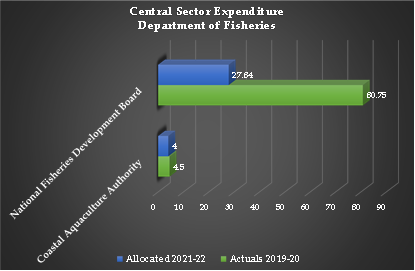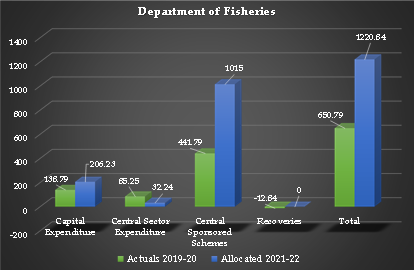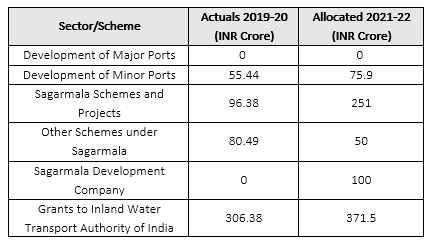Overview
“The Government of India has taken several initiatives to harness the untapped potential of the sector. The centrally sponsored scheme – Blue Revolution (CSS-BR) which was launched in 2015-16 for a 5-year period with a central financial outlay of` 3000 crores to catalyse the “Integrated, Responsible and Holistic Development and Management of the Fisheries Sector”, ended in March 2020. The Government of India in October 2018 approved the establishment of a dedicated Fisheries and Aquaculture Infrastructure Development Fund (FIDF) at 7522 crores…
Realizing the potential, scope and importance of the fisheries sector, new flagship scheme Pradhan Mantri Matsya Sampada Yojana (PMMSY) was launched in May, 2020 as a part of Atma Nirbhar Bharat Package by Government of India with an estimated investment of` 20,050 crores comprising of central share of` 9407 crores, state share of`4880 crores and beneficiaries’ contribution of` 5763 crores for a period of five years from FY2020-21 to FY2024-25. PMMSY aims to enhance fish production to 220 lakh metric tons by 2024-25 at an average annual growth rate of about 9 percent. The ambitious scheme will result in doubling export earnings to 1,00,000 crores and generate direct and indirect employment opportunities of about 55 lakhs in the fisheries sector over a period of the next five years. PMMSY further intends to increase aquaculture productivity to 5 tonnes per hectare (up from national average of 3 tonnes per hectare), enhance domestic fish consumption and attract investments in fisheries sector from other sources. Insurance coverage for fishing vessels is being introduced for the first time under PMMSY.”
– Excerpts from the Economic Survey of India, Volume 2, 2020-21
The Budget 2021-22 is the second budget since the formation of the Department of Fisheries at the Central level. The Finance Minister’s speech focused only on the main points related to Fishing Harbours and Fish Landing Centres. This sends clear indications of the trend to expand marine fisheries into deeper waters. However, the reading of fisheries budget, along with the Economic Survey points to the fact that high rates of growth and productivity are being achieved in inland fisheries and propelling the sector’s growth. This has resulted in India’s fish production continuing to grow at 9% with plans to reach 20 million (200 lakh) tons by 2022-23. This growth rate and target is well on track to reach the goals as proposed by the ‘Pradhan Mantri Matsya Sampada Yojana’ (PMMSY) and the ‘Draft National Fisheries Policy’ (NFP) by 2030. As a result, it becomes important to understand that the budget must be read alongside the plans as outlined in the PMMSY and the NFP, in addition to linking it to the national plans to advance logistics such as the building of a national cold supply chain encompassing agri-produce, horticulture etc. and within the different components of the Blue Economy.
The budget speech has highlighted all major components of BE, which has committed public investments to programmes like Deep Ocean Mission, Sagarmala, Waste Management (Coastal Pollution), Oil and Gas, and Renewable Energy. Featuring them in the main speech indicates the importance attached to these programmes by the government. With the National Fisheries Policy 2020 also advocating for eventually having a Ministry of Fisheries and Marine Affairs, BE is emerging as a core of the planning process in a sense, and the Budget has reiterated this focus
Fish production related highlights:
- The fish production in India has reached an all-time high of 14.16 million metric tons during 2019-20.
- Further, the Gross Value Added (GVA) by the fisheries sector to the national economy stood at 2,12,915 crores constituting 1.24 per cent of the total national GVA and 7.28 per cent of the agricultural GVA.
- By mid-January 2021, proposals under the PMMSY scheme with an outlay of 6,567.20 crores were received from various States/UTs against which project proposals with total outlay of 2309.08 crores have already been approved.
- As of mid-January 2021, a total of 44,673 Kisan Credit Cards (KCCs) have been issued to fishers and fish farmers and an additional 4.04 lakh applications from fishers and fish farmers are with the banks at various stages of issuance.
PMMSY Allocation:
- Proposals to the tune of 6567.57 Crores have been received from 34 States/UTs along with additional proposal in phase–II from 10 States/UTs.
- Project Approval Committee (PAC) led by CE, NFDB has approved and forwarded to Department of Fisheries (DoF) for release of the proposals to the 2642.38 crores with admissible central share of 915.36 Crores form 34 States/UTs.
- Proposals from Eighteen (31) States/UTs (except Tripura, Sikkim, Damn& Diu, WB and Chandigarh) at a total cost of 2267.62 Crores involving central share of 772.60 Crores have been approved and 1st instalment of Central share of 339.12 Crores have been released.
- Proposals from 2 States viz. Tripura and Sikkim, & Additional proposals from 7 States namely Himachal Pradesh, Tamil Nadu, Bihar, Andhra Pradesh, Mizoram, Andaman & Nicobar and Lakshadweep at a total cost of 273.72 Crores with central share of 103.37 Crores have been scrutinized by NFDB and being processed for releases.
The budget speech specifically mentions building several Fish Landing Centres in addition to Fishing Harbours in Kochi, Chennai, Visakhapatnam, Paradip, and Petuaghat to be developed as hubs of economic activity. The government also proposes to develop inland fishing harbours and fish-landing centres along the banks of rivers and waterways. FLCs indicate the central government’s attempts to woo fishers through implementing demands of some fishing villages, but through also intrude into fisheries governance at the local level stealthily as all FLCs will also be accompanied by Management Committees which will feature several government and police officials. The specific targeting of Kochi, Chennai, Vizag, Paradip for the fishing harbours indicate the government views these as the centres of the Deep-Sea Fishing and related Tuna processing units it is promoting.
As per the speech of the Finance Minister, there are plans to strengthen the fisheries supply chain through linkages to air, rail and sea transport, in addition to lengthening the chains, both domestically and internationally. The following are proposed under the ‘Kisan Rail’ project:
- In order to effectively implement this project, the requisite initiatives as required would be taken up by the Department of Fisheries in consultation with concerned Ministries/Departments. In this context, a pilot study on Kisan Rail for transport of fish initially for following two sectors for undertaking feasibility study is under process:
- Vijayawada – (or nearby towns) – Howrah – Guwahati, Silchar primarily catering Inland Fisheries.
- Vijayawada – (or nearby towns) – Nellore – Chennai – Kochi primarily catering marine fisheries.
Similarly, there are also plans to integrate fish into the ‘Krishi Udaan’ project to be able to transport fish by air domestically.
The special focus on seaweed industries was highlighted in the speech through the announcement of “Multipurpose Seaweed Park” in Tamil Nadu, presumably in Palk Bay and Gulf of Mannar where these ventures have been pushed through for the last 10 years. After a massive collapse in the near shore environment leading to collapse to seaweed farming by fishers. PMMSY and Neel Kranti has re-introduced Seaweed farming to coastal people in this area, in addition to all areas with calm coastal waters. But with ‘Seaweed Parks’, the agenda of the govt seems to be seaweed farming on an industrial scale and intensity, along with facilitating private investments into value addition and post-harvest operations, creating ready to export final products. No doubt this represents a strong buy-in for the global narrative of seaweeds as the next wonder crop for global food trade, and an implementation of the vision espoused through National Fisheries Policy 2020, even before it is formally ratified. Specific to the Tamil Nadu context, it also forms part of the right-wing organisations long term plan to capture those coasts along the Palk Bay and Gulf of Mannar.
Multiple initiatives as outlined in the PMMSY such as the formation of FPPOs, Sagar Mitras, issuance of Kisan Credit Cards, certification schemes, guidelines/action plans/model bills are well underway. All details related to these can be found in “Implementation of Budget Announcements 2020-2021“.
A. Department of Fisheries:
The overall budget sees an increase from INR 825 crores to a total of INR 1220.84 crores, indicating an increase by about 32%. The ‘Integrated Development and Management of Fisheries’ has been rescinded and been replaced by the PMMSY for which INR 1000 crores have been earmarked, a sum that is more than twice the amount spent last year.
There are a few trends within the budget allocations that need to be paid attention to:
- The budget allocation for the National Fisheries Development Board has been dramatically slashed. While the NFDB bill has not yet been passed, the slashing of the budget is an indication of the trimmed manner in which the NFDB shall function henceforth, with government roles and functions fused together with private actors;
- The allocation to the North East regions has been increased substantially as well. As seen in the PMMSY, the project costs in the region due to accessibility and distance were estimated to be higher, and the intention of the Centre to undertake fisheries production in these regions is evident;
- The Coastal Aquaculture Authority budget has been slashed marginally. Given the pace at which intensive shrimp aquaculture is growing, as well as its future prospects, given the under-capacity of the CAA, a budget increase should have been implemented to improve environmental monitoring of the sector;
- Both States and UTs see an increase in their grant amounts. Given that the PMMSY in States is set up on a 60-40 basis, in addition to most projects being Beneficiary oriented, the overall increase from the Centre will need to be further clubbed with other State/Private investments to understand the size of the fisheries investments. This is an indication of the massive unregulated and unsustainable growth of aquaculture envisaged by the government.
In the coming weeks, when the DOF presents its report to the Standing Committee on Agriculture, specific details regarding the spending over the last year shall emerge and help add more context to the direction in which this increased budget is shaping fisheries.
B. Ministry of Environment, Forests and Climate Change:
The overall budget that falls under the purview of the MoEFCC that related to fisheries sees an increased allocation overall. Pertinent to this is the near doubling of the National Coastal Mission, the mandate of which is as follows:
National Coastal Management Programme – Ministry is responsible to ensure livelihood security of coastal communities including fisher folks, to conserve, protect the coastal stretches and to promote sustainable development based on scientific principles. The Ministry is also responsible for conserving, protecting and promoting sustainable development in the islands of Andaman & Nicobar and the Lakshadweep. A World Bank assisted Integrated Coastal Zone Management Project is implemented in the coastal States and Union Territories.
It is worrisome that the increased budget is likely oriented towards expanding the WB ICZMP, the pilot study of which was completed in June, 2020 and is likely to be extended to the entire coastline of India.
C. Sagarmala:
The allocations under Sagarmala have changed significantly in relation to the allocation for Major Ports, which has been slashed to zero, and various Schemes and Projects, which sees a 16% increase in allocation. Given the scope of the National Fisheries Policy, including the announcement by the FM on the establishment of 5 modern fisheries harbours, a monitoring of the funds allocated to Minor Ports under Sagarmala would need to be kept in order to see how they are funded. Various state governments are also building fishing harbours through the FIDF route and there is an overlap in some of the minor ports and fishing harbours.
Ports were mentioned in the FM’s speech as follows, “Our sea-ports need to be more efficient. Technology has to be used to improve performance. A governance framework keeping with global benchmarks needs to be put in place. This government would consider corporatizing at least one major port and subsequently its listing on the stock exchanges”. Read with the ‘Major Ports Authority Bill, 2020’, the changing nature of Major Ports’ operations under Sagarmala will need to be understood better. The budget speech specifically highlighted that Major Ports will be moving from managing their operational services on their own to a model where a private partner will manage it for them.
Seven major ports worth ₹2,000 crore will see their operations privatised in the year 2021-2022, Finance Minister mentioned. The Finance Minister also announced a subsidy scheme of ₹1,624 crore for a period of five years for Indian shipping companies to encourage more merchant ships with Indian flags.[1]
D. Other sectors
Other sectors that are related to Fisheries, that include spending on research, the coast guard, export councils, disaster management see an overall marginal increase in budgets, and all components have been maintained. The budget speech has reiterated its support to long term programmes like Deep Ocean Mission, while the increased allocation to the Coast Guard indicates its expanded role in militarising India’s coasts and their roles in Fisheries Management, as envisaged by National Fisheries Policy.
Overall, the budget does not contain any of the details awaited by the fishing communities. The pandemic and lockdown had devastated the fishing sector and the communities as a whole. Increased welfare support through improved coverage for Savings-cum-Relief schemes and Ban-time compensation has not been mentioned. Among the major demands of the fishers were some relief from rising fuel costs with the fishers having organised several strikes against rising Petrol and Diesel prices, without any change to their fuel subsidies. The budget documents have not provided funding details of the subcomponents provided within PMMSY to address any of these questions.
[1] https://www.thehindu.com/business/budget/union-budget-2021-seven-major-ports-worth-2000-cr-to-be-privatised/article33721402.ece










